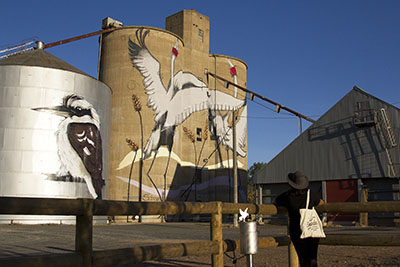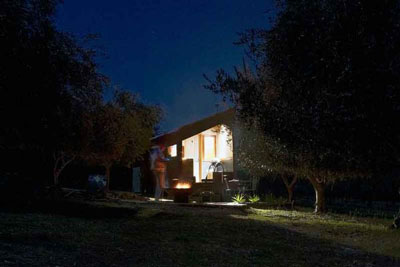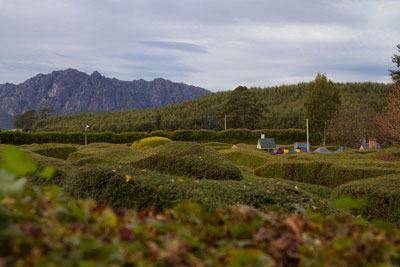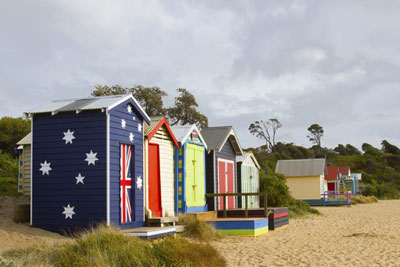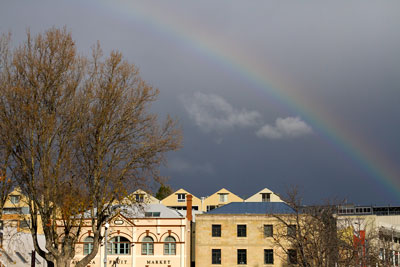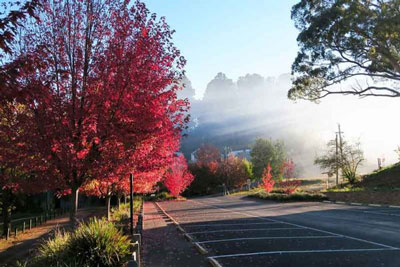Cockatoo Island camping: cheap Sydney harbour views
Did you know there’s an island located in Sydney Harbour that you can stay on overnight? Find out more about Cockatoo Island camping – how to get there, what you need to bring and why you should put it on your Sydney itinerary.

Did you know you can go camping (or glamping) on an island in Sydney Harbour?
Yup. There are so many unique things to do and see in Sydney.
You can spend all your time in the NSW capital exploring the many wacky and weird options on offer.
If you’re looking to do something a little different, I highly recommend camping or glamping on Cockatoo Island.
It certainly makes for a fun date idea in Sydney.
Accessible via ferry, Cockatoo Island is a UNESCO World Heritage Site and an important part of the city’s history.
Originally, the area was inhabited by the Eora People, who are Indigenous to this part of the country. The island is traditionally known as ‘Wareamah’, believed to mean “woman land”.
After European settlement it became a convict site, then a reformatory school for orphaned and criminal girls.
It functioned as an industrial space for shipbuilding, before being handed over to the Sydney Harbour Federation Trust in 2001.

This guide to Cockatoo Island camping & glamping will cover:
|

Visiting Cockatoo Island
These days, visitors can take a day trip to the island, to explore it and its history self-guided or as part of an organised tour.
Not only that – you can spend the night! Indulge in Cockatoo Island camping, glamping, or stay at one of the several accommodation options on offer.
In this post, I’ll outline the options available to those who wish to spend the night, relaying what it is like from my own personal experience.
You’ll find out what there is to do on the island and gain a brief overview of its history.
With luck, this will inspire you to get out and explore this fascinating island for yourself.
Cockatoo Island camping & glamping
So, why camp or glamp on Cockatoo Island? It’s a truly unusual experience to have in Sydney, waking up to million dollar harbour-side views, for a fraction of the cost.
The island itself is rife with history and has everything you need to have a memorable night.
Read on to find out what accommodation options are available on Cockatoo Island and what you can get up to during your time there.

As far as Cockatoo Island camping goes, there are two options.
You can book the campsite only and bring everything you need, or you can spend the night in one of the island’s own tents.
Camping on Cockatoo Island
Those who love camping and have the gear, or are lovers of budget travel, can bring their own tent or swag. The island offers accommodation for up to four per site.
There are obvious pros and cons to this. It’s incredibly cheap, compared to all other options.
It’s a pretty unreal experience to spend this little and wake up to the million dollar views of Sydney Harbour in the morning.
On the flip side, you’ll have to bring everything you need with you onto the island and probably do so via ferry.
The costs for the Cockatoo Island campground with BYO tent are:
- Monday to Thursday – from $50 per night.
- Friday to Sunday – from $60 per night.

Glamping on Cockatoo Island
If you’re not a happy camper or are balking at the idea of carrying around extra gear, you can spend the night in a deluxe camping tent.
This way, all the hard work is done for you. You get the bedding, some toiletries and a torch.
For a little extra, you can choose a tent with a waterfront view.
I will say, it is a shame that utensils aren’t provided in this option. They’re an added extra you have to pay for.
You can also purchase prepacked BBQ kits, to cook up on the provided facilities.
To save on dosh, we popped to a supermarket and bought all the food we needed, along with some utensils for cooking, which we could reuse. This worked out perfectly fine.
Read this post if you’re after some eco-friendly and reusable options for travel.
Costs for the glamping package are:
- Monday to Thursday – from $135 per night.
- Friday to Sunday – from $160 per night.
The tents sleep two, but there are larger family-friendly tents on offer.
Cockatoo Island is fully licensed and you can’t BYOB. Bags are searched at the entrance, to ensure nothing is smuggled in.
It’s possible to buy a bottle of vino or beers at the Societe Overboard cafe near the Visitor’s Centre – just make sure you get there before it closes!

Other accommodation options on Cockatoo Island
If camping or even glamping isn’t quite your thing, there are plenty of other spaces on the island to kip in overnight. Do note – most have a weekend stay of two nights, minimum.
Heritage Houses – there are two houses set up on top of the hill, which easily accommodate up to 12 guests. The cost is $625 per weekday night and $950 for a weekend.
Harbour View Apartments – these do what they say on the box, offering up spectacular views of Sydney Harbour. Each apartment can accommodate up to five guests. The two bedroom apartments cost $410 on a weekday and $515 for the weekend. The single bedroom is $295 on a weekday and $355 per night.

Garden Riverview Apartments – these apartments look out at the opposite side of the harbour, towards Woolwich and Hunters Hill. They can accommodate up to four guests. The two bedroom apartments cost $375 at a weekday price and $470 on the weekend. The single is priced at $310 per weekday night and $345 on weekends.
Fire Station Studio – this is formerly the island’s fire station, now converted into small apartments. The cost is $275 per weekday night, $325 on the weekend.
Prices may vary on public holidays and during special events, so keep this in mind when booking.

Getting to Cockatoo Island
Cockatoo Island is accessible by ferry, a method of public transport in Sydney that still delights me, after all my life so far.
The F3 and F8 services run to Cockatoo Island daily. You can catch these from Circular Quay, Darling Harbour and Barangaroo as well as from wharves along Parramatta River.
The trip will take between 10 and 30 minutes, depending on where you embark.
Sydney’s ferries are reasonably priced and an excellent and easy way to tour the Harbour. You can access them using Opal cards, the state’s own transport access cards.
Read more about using the Opal Card in Sydney, as it’s baffling and ever-changing.

What to bring & facilities on-site
It highly depends on which accommodation option you’re taking.
I strongly recommend bringing both mozzie repellant and sunscreen, if you’re visiting in the summer. The former will come in handy if the weather in Sydney has been particularly wet.
If you want to explore the island, bring a pair of shoes that are comfortable to walk in.
There are plenty of facilities on-site for campers. There’s a decent toilet block and showers, which are quite clean. A campfire is lit in the cooler months (so not during summer and fireban season).
Although I didn’t stay in the other accommodations, according to the trust website, they have just about everything you need, bar food and booze.

The cafés provide food on-site but close fairly early, so you’ll need to bring dinner and snacks.
Most of what you need can be purchased at the Visitor Centre.

Cockatoo Island history
Although there’s evidence that the First Nations Eora People used this area and the mainland surrounding it, what you’ll see when you visit today is a result of European settlement.
You may or may not know that Australia was originally intended as an outpost for London prisons, which were crammed full to the bursting.
As such, there are remnants of convict settlements all over the country – notably in Sydney and Tasmania. This is because they were the first areas of Oz to be colonised after the British invaded Australia.


In 1839, sixty prisoners were transferred to Cockatoo Island. This number would reach as high as 500, on a site that was meant for around 300.
Conditions were grim and the convicts were subjected to backbreaking work, constructing the buildings and shipyards you see on the island today.
Sickness and disease was rife on the island and prisoners were forced to pay for food through their own work.

Post-penal: a place of ‘learning’
The penal settlement closed in 1869 and reopened as an industrial school and reformatory for girls from 1871 until 1888.
The industrial school was ostensibly for orphans and the reformatory for young women who’d broken the law.
Having everyone housed together led to vast problems, as the orphans mixed with troubled young girls. Treatment at the schools was cruel and often inhumane.
After Biloela was closed, Cockatoo Island became the official dockyard of the Royal Australian Navy in 1913. During World War II, it was the main ship repair facility in the southwest Pacific.


The island enjoyed a maritime boom until the 1970s, when shipbuilding rapidly declined. The dockyard was officially shut down in 1991.
Today, it offers a range of experiences to both Sydneysiders and visitors to the NSW capital, looking to get a bit of the beaten path and explore some of Sydney’s rich and varied historical sites.

Things to do on Cockatoo Island
It’s pretty easy to while a few hours away on Cockatoo. Here’s some of what you can get up to.
1. Take a tour
There’s a range of tours available on Cockatoo Island.
Namely history and ghost tours, you can check out the options on offer.

2. Have your own poke around
We didn’t jump on an organised tour, mostly due to the fact that they’re held over the weekend.
It’s a shame, as if there’s a ghost tour in a place, I’m usually there.
Instead, we self-toured around the Convict Precinct, using a map and following paths. Having hardly anyone else in the area at the time made it feel quite creepy!
You can pick up an audio guide to take on your own tour from the Visitor Centre.
Those wanting to learn more about the island’s history should download the “Ghosts of Biloela”, which tells stories of the island from the 1870’s, when homeless girls were sent to live there.
It’s a sad history, albeit a truly fascinating one.
3. Come for the Biennale or SailGP
Cockatoo is the setting for both the Biennale of Sydney and the SailGP.
In fact, they were prepping the boats when we visited. It was cool to see, but also slightly annoying as there were parts of the island that closed to the public for this reason.
Concerts are often held on the island, too. Their site has a What’s On section, which will be worth checking out before you visit.
Cockatoo Island is an amazing place to spend NYE, too.

4. Play a game of chess or shoot some hoops
Stimulate your body with a game of basketball, using the provided hoops on the harbour-side court.
Alternatively, you can exercise your mind by playing a game of chess on the giant chessboard located on site.
There’s also a range of vintage games, available from the Visitor Centre.
5. Catch a movie
Films are screened in the historic Convict Precinct, which is pretty neat.
The Campground Cinema can accommodate up to 30 people and for $5, you can be included within their numbers (you get popcorn for this price as well).

6. Grab a drink or a meal at the cafes on the island
There are two licensed venues on Cockatoo – Societe Overboard, located near the Visitor’s Centre and The Marina Cafe, on the opposite side of the island to the campground, near the Docks Precinct.
You can have meals here, grab a drink or purchase alcohol that you can then consume within your accommodation.
Cockatoo Island is also the perfect setting for a picnic, if you fancy bringing along your own meal.
7. Go for a kayak
If you’re local, don’t want to catch the ferry and own your own kayak, then you can use it to navigate to the island and park at Slipway Number 2.
We certainly saw many people kayaking past on the harbour during our time there. What a life.
Unfortunately, there’s no kayak hire available on the island itself.

What it’s like to stay overnight
The night I spent on Cockatoo Island was my 30th birthday.
I wanted to do something special and as we were only in Sydney for a couple of days, we decided to go for a glamp.
The night itself
We pick a Thursday night at the end of summer, so the campground is fairly empty. There are a few other couples and a group of school kids, but that is it.
We are lucky enough to score a tent right in front of the harbour. After a disgustingly hot day, it’s nice to sit by the water, enjoying the cool breeze and having a few cold drinks.
Before sunset, we explore the island, which is a cool and slightly spooky experience! As the last ferry has left for the day, there is hardly anyone else poking about.
We’ve brought our own food to BBQ (’tis the Australian way, after all) – there are plenty of facilities onsite. We haven’t opted in for any of the extras such as utensils, but have brought our own mini camping kit. It suffices.
It is a lovely balmy evening. A summer thunderstorm rolls in and hangs over nearby Drummoyne. We watch the lightning flicker over the harbour, before retiring at a respectable hour to sleep.
The beds inside the tent are quite comfortable. I have no issues nodding off quickly.

The next morning
We are up early the next morning, woken naturally by the sound of seagulls.
We shower at the nearby facilities and pack everything up, before heading to one of the island’s cafés for some brekky.
Shortly after that, we bid farewell to Cockatoo Island, catching the ferry back to Circular Quay.
All in all, I highly recommend making your way out to Cockatoo, if you’re in Sydney. It’s a lovely way to celebrate a special occasion, or just something to do for fun!
You don’t have to stay the night – even exploring the island has its own rewards.
All in all, Cockatoo Island camping, glamping or otherwise is a wonderful experience to have in Sydney. I highly recommend it to visitors, or those who call Sydney home and are looking to explore their own backyards a little further.
Is Cockatoo Island camping something you’d like to do? Or have you done it already – if so, what did you think of the experience?
Looking for places near Sydney to travel to? Check out our guides on Newcastle, Maitland and Lake Macquarie.
Find out what to expect if you’re travelling to Australia for the first time, including some tips for proper etiquette. And discover what you need to know before you move to Australia. We have plenty of content on Australia – check out our archives for more.
This experience took place on the lands of the Eora People. We acknowledge them as Traditional Owners and pay our respects to their Elders, past and present.
All prices listed are in AUD. Prices are current at time of writing or review.


